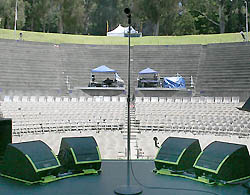
Rap Wedges
If you’ve ever had the experience of working with a rap act (or other very loud concert) with performers running around with wireless mics, you’re familiar with the frustration of trying to get the wedges loud enough.
The usual stage monitor setup has pairs of wedges across the front of the stage, supplemented by enormous side-fills. If the wedges are rearranged in symmetrical pairs so that they’re equidistant from the center of the stage, then it becomes relatively easy to apply minor timing delays into each mix to synchronize them with the side-fill’s arrival at that position.
The secret to making this work is to place the side-fills low and angle them up, or even better, to fly the side fills, so that each fill mainly covers its own side of the stage.
Co-Axial Wedges
With the introduction in the ’80s of coaxial drivers in studio monitors, the road was paved for development of more accurate-sounding wedges. Two-way loudspeakers can employ time-offset correction using modern DSP, but that only works for a single on-axis point, except for coaxial drivers where minor delay synchronizes both transducers throughout their entire coverage pattern.
Coaxial floor monitors are naturally smaller, because the horn exists within the woofer, and they also solve the age-old problem of book-matching left and right low profile versions for double-wedge positions.

PAS was an early innovator due to their involvement with the UREI 813B, and their 15-inch SW coaxial wedges are still tops in the category. L-Acoustics’ 115XT HiQ is a modern example of a coaxial loudspeaker enclosure with floor monitor angles that also incorporates a pole-mount cup and rigging points, to provide extra functionality as a distributed zone or fill loudspeaker. The EAW MicroWedge has a built-in angle to help build multiple cabinet wedges into an arc.
Input Channel EQ
Most manufactured professional monitors exhibit fairly smooth, flat frequency response. It’s common for monitor engineers to take the vocal microphone du jour and repeat the mantra of “Test: one, two” while exercising the graphic EQ, whether out-board of an analog desk or inside a digital console. This results in some predictable results.
The mic’s proximity effect, in combination with the enclosure’s half-space coupling with the floor persuades the operator to cut 160 Hz. The mic’s presence peak, combined with compression driver’s efficiency below its mass break point convince us to cut 2,500 or 3,000 Hz. With two wedges angled inwards, frequencies just below the crossover point must be tamed with a cut around 1,000 Hz.
When a wedge sounds “boxy” it’s often blamed on “room modes,” though it usually comes from a response peak around 300 Hz, where the woofer becomes directional and enjoys the extra gain of baffle loading.
After you’ve carved up your wedge for the vocal application, how will the instruments sound? What if you took the four-band input EQ and used it to make the vocal sound natural instead? While you’re at it, roll the high-pass up to 150 Hz. There, that’s better.
Using channel EQ runs counter to the common wisdom of “tuning” the loudspeaker and the vocal mic with output EQ, but there are several practical applications. A simple lack of output EQ, a support act using spare inputs on a headliner’s monitor console, using a single console for both FOH and monitors by splitting inputs to double channels, and finally splitting monitor desk inputs to double channels for both wedges and IEM.
Mark Frink is a long-time live sound mix engineer and writer/editor on pro audio topics.
